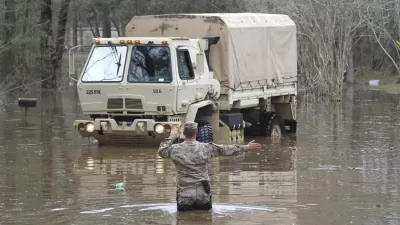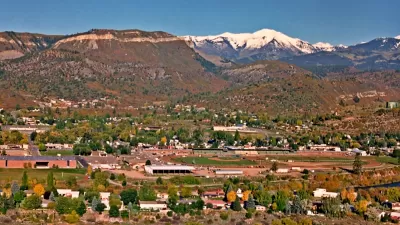The U.S. Department of Agriculture in January announced an ambitious, and only partially funded, new plan to reduce wildfire risks for communities around the United States.

The Biden administration recently announced a new federal program, with funding from the Infrastructure Investment and Jobs Act (IIJA), to thin forests and reduce wildfire risk on 50 million acres in the United States.
A "Wildfire Risk Strategy" [pdf] announced in January by the U.S. Department of Agriculture would spend an estimated $20 billion over 10 years for work in national forests, in addition to $30 billion for work on other federal, state, tribal, and private lands.
Agriculture Secretary Tom Vilsak announced the plan, with the longer title "Confronting the Wildfire Crisis: A Strategy for Protecting Communities and Improving Resilience in America’s Forests," with a press release on January 18.
"The strategy outlines the need to significantly increase fuels and forest health treatments to address the escalating crisis of wildfire danger that threatens millions of acres and numerous communities across the United States," according to the press release.
In addition to the new levels of funding, the plan also proposes a change to wildfire prevention strategy by focusing risk mitigation at the wildland-urban interface—specifically what Forest Service scientists have identified as high risk "firesheds, described by the press release as "large, forested landscapes with a high likelihood that an ignition could expose homes, communities, infrastructure and natural resources to wildfire."
As noted in an article by Alyssa Lupkat for the New York Times, the Agriculture Department is proposing to spend $655 million annually on forests for the first five years of the new Wildfire Risk Strategy. "That money would be added to $262 million that the U.S. Forest Service had already allocated to the task for this year," according to Lupkat. With an initial $3 billion from the IIJA, the full $50 billion of spending proposed by the ten-year plan has not yet been allocated.
FULL STORY: Secretary Vilsack Announces New 10 Year Strategy to Confront the Wildfire Crisis

Maui's Vacation Rental Debate Turns Ugly
Verbal attacks, misinformation campaigns and fistfights plague a high-stakes debate to convert thousands of vacation rentals into long-term housing.

Planetizen Federal Action Tracker
A weekly monitor of how Trump’s orders and actions are impacting planners and planning in America.

San Francisco Suspends Traffic Calming Amidst Record Deaths
Citing “a challenging fiscal landscape,” the city will cease the program on the heels of 42 traffic deaths, including 24 pedestrians.

Defunct Pittsburgh Power Plant to Become Residential Tower
A decommissioned steam heat plant will be redeveloped into almost 100 affordable housing units.

Trump Prompts Restructuring of Transportation Research Board in “Unprecedented Overreach”
The TRB has eliminated more than half of its committees including those focused on climate, equity, and cities.

Amtrak Rolls Out New Orleans to Alabama “Mardi Gras” Train
The new service will operate morning and evening departures between Mobile and New Orleans.
Urban Design for Planners 1: Software Tools
This six-course series explores essential urban design concepts using open source software and equips planners with the tools they need to participate fully in the urban design process.
Planning for Universal Design
Learn the tools for implementing Universal Design in planning regulations.
Heyer Gruel & Associates PA
JM Goldson LLC
Custer County Colorado
City of Camden Redevelopment Agency
City of Astoria
Transportation Research & Education Center (TREC) at Portland State University
Jefferson Parish Government
Camden Redevelopment Agency
City of Claremont





























